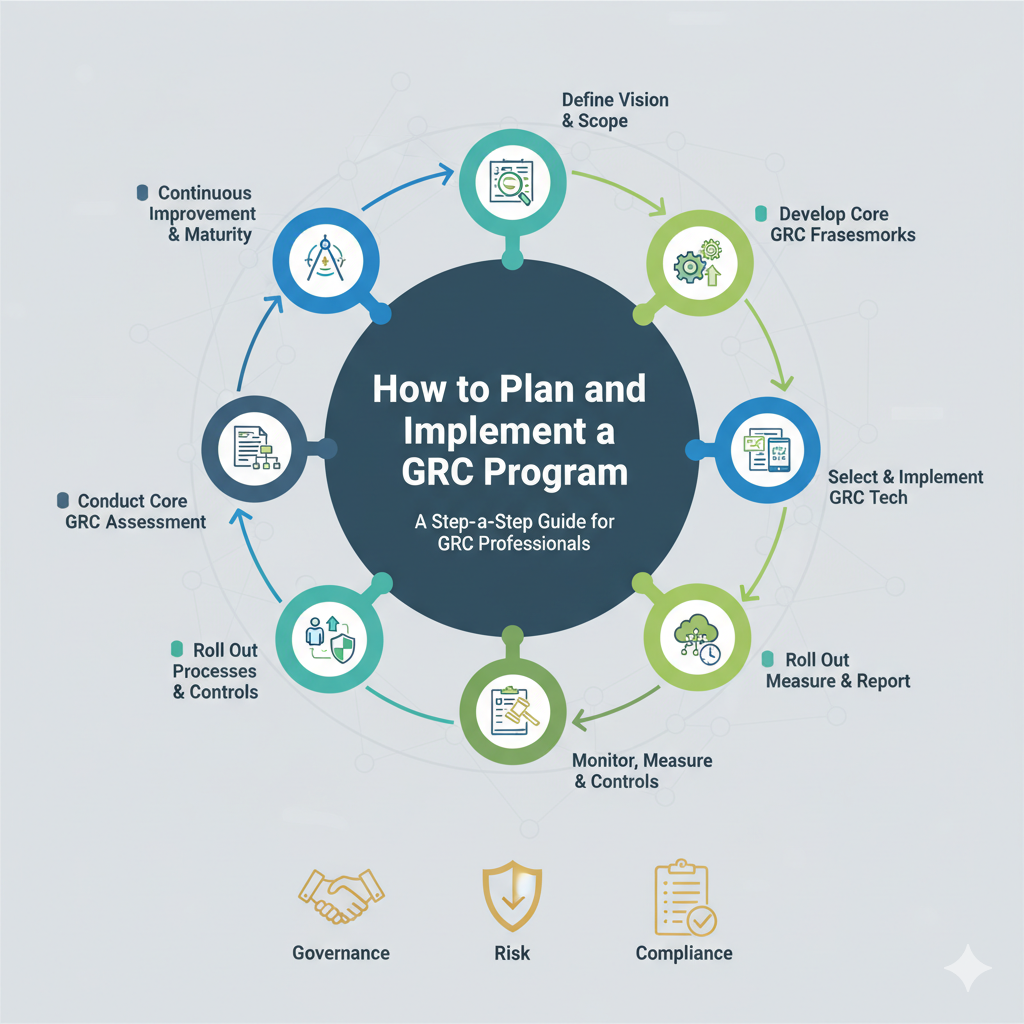
How to Plan and Implement a GRC Program: A Step-by-Step Guide for GRC Professionals
Compliance requirements evolve rapidly and cybersecurity risks continue to escalate, implementing a robust Governance, Risk, and Compliance (GRC) program has become essential for modern enterprises. A well-designed GRC framework not only safeguards your organization’s data but also ensures operational efficiency, regulatory alignment, and business resilience.
This step-by-step guide walks GRC professionals through the planning and implementation process helping you streamline risk management, automate compliance, and strengthen governance with the Risk Cognizance GRC Platform.
Understanding GRC and Why It Matters
Governance, Risk, and Compliance (GRC) is the integrated approach organizations use to manage risk, align operations with business goals, and ensure adherence to internal and external regulations.
Traditional compliance efforts are often fragmented, creating inefficiencies and blind spots. A modern GRC platform unifies these activities through automation, data analytics, and centralized visibility enabling continuous monitoring and faster decision-making.
Risk Cognizance offers an AI-powered GRC platform that simplifies governance and compliance, helping organizations manage cybersecurity posture across complex infrastructures.

Step 1: Define Objectives and Scope
Before implementing a GRC program, establish clear goals:
What risks are you trying to mitigate?
- Which regulations and standards (ISO 27001, NIST, GDPR, etc.) apply to your business?
- What departments, processes, or data sets will fall under the GRC umbrella?
At this stage, it’s critical to involve key stakeholders including compliance officers, IT leaders, and business unit managers to align the program with organizational priorities.
Step 2: Conduct a Risk and Compliance Assessment
A successful GRC program begins with understanding your current risk posture.
Risk Cognizance’s Enterprise Cyber Risk & Security Platform helps organizations identify vulnerabilities, assess compliance gaps, and prioritize remediation efforts.
This includes:
Performing a baseline risk assessment
- Mapping existing controls to frameworks like NIST and ISO 27001
- Identifying process inefficiencies and redundant manual workflows
Automated assessments streamline this process, providing real-time visibility into enterprise-wide risk exposure.
Step 3: Design Your Governance Structure
Effective governance ensures accountability and oversight. Define clear roles and responsibilities:
- Governance: Establish policies, roles, and reporting structures.
- Risk: Assign owners for each risk area and define escalation procedures.
- Compliance: Create monitoring mechanisms and audit trails.
The Risk Cognizance GRC Platform centralizes policy management, ensuring all documentation is version-controlled, easily accessible, and aligned with evolving regulations.
Step 4: Choose the Right GRC Technology
Selecting the right technology is pivotal for long-term success. A comprehensive GRC software platform like Risk Cognizance combines automation, analytics, and continuous control monitoring to simplify compliance and risk management.
Key features to look for:
- Risk Management: Identify, assess, and mitigate threats to your IT and business infrastructure.
- Compliance Automation: Align with regulatory frameworks and certifications.
- Policy & Audit Management: Centralize creation, tracking, and approval processes.
- Continuous Monitoring: Gain ongoing visibility into risk and control effectiveness.
Risk Cognizance’s AI-driven platform delivers all these capabilities in a unified cloud environment—enabling organizations to assess, measure, remediate, and communicate their risk posture with confidence.
Step 5: Implement, Integrate, and Automate
Once your GRC framework is defined, begin implementation with an Agile methodology to ensure flexibility and incremental progress.
With Risk Cognizance’s Continuous Compliance Automation Tool, organizations can automate repetitive processes, integrate third-party data sources, and continuously monitor compliance controls.
This phase typically includes:
- Configuring risk and compliance workflows
- Automating policy enforcement
- Integrating with security tools and business applications
- Establishing dashboards and alerts for ongoing oversight
Automation reduces manual errors and ensures real-time governance across all operational levels.
Step 6: Train, Communicate, and Foster a GRC Culture
Technology alone isn’t enough—success depends on people. Train employees to understand their roles in risk management and compliance. Use the GRC platform’s reporting and dashboards to maintain transparency across departments.
Risk Cognizance enables collaboration through centralized communication tools, ensuring all stakeholders—from executives to compliance teams—stay aligned on risk objectives and mitigation actions.
Step 7: Monitor, Audit, and Continuously Improve
Continuous improvement is the hallmark of a mature GRC program. Regular audits, performance reviews, and updates to risk controls are essential to stay ahead of new threats and regulatory changes.
Risk Cognizance Automated GRC Software provides ongoing compliance monitoring and real-time alerts, helping organizations maintain audit readiness and proactively address control gaps.
Benefits of a Strong GRC Program
Implementing an integrated GRC framework powered by automation delivers measurable benefits:
- Reduced compliance costs
- Streamlined audits and evidence collection
- Enhanced cyber resilience
- Improved decision-making with real-time insights
- Strengthened regulatory posture
Conclusion
Planning and implementing a GRC program requires strategy, collaboration, and the right technology. By following a structured approach and leveraging platforms like Risk Cognizance GRC professionals can build a resilient governance structure that ensures continuous compliance and protects organizational integrity.
Risk Cognizance provides an intelligent, cloud-based solution that unifies governance, risk, and compliance operations—empowering enterprises to stay secure, efficient, and audit-ready.

.png)
